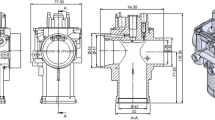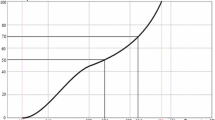Abstract
In this paper, are presented design and implementation issues of predictive models developed for improving the quality of aluminum die castings by minimizing scrap due to porosity. A predictive model for porosity of casting parts is created using fuzzy systems optimized by genetic algorithm and simulated annealing. High-pressure die casting is a complex process that is affected by a large number of process parameters with influence on casting defects such as porosity. In this study, porosity of casting parts is expressed as a function of counter-pressure, first phase velocity, first phase length, second phase velocity, first cooling period, and second cooling period. It was found that the developed GA- and SA-based fuzzy systems have great predictive capability of porosity in die castings. The second objective of this work was to obtain a group of optimal process parameters leading to minimum porosity in high-pressure die casting using genetic algorithm and simulated annealing as optimal solution finders. The optimal parameters were validated experimentally, and the castings with minimum percentage of porosity were achieved.







Similar content being viewed by others
References
G.P. Syrcos, Die casting process optimization using Taguchi methods. J. Mater. Process. Technol. 135(1), 68–74 (2003)
V.D. Tsoukalas, S.A. Mavrommatis, N.G. Orfanoudakis, A.K. Baldoukas, A study of porosity formation in pressure die casting using the Taguchi approach. Proc. Inst. Mech. Eng. B J. Eng. Manuf. 218(1), 77–86 (2004)
K.S. Anastasiou, Optimization of the aluminium die casting process based on the Taguchi method. Proc. Inst. Mech. Eng. B J. Eng. Manuf. 216(7), 969–977 (2002)
U.A. Dabade, R.C. Bhedasgaonkar, Casting defect analysis using design of experiments (DOE) and computer aided casting simulation technique. Proc. CIRP 7, 616–621 (2013)
J.K. Kittur, M. Choudhari, M. Parappagoudar, Modeling and multi-response optimization of pressure die casting process using response surface methodology. Int. J. Adv. Manuf. Technol. 77(1–4), 211–224 (2015)
Y. Wang, S. Wu, L. Niu, Zhang J. Xue, W. Xiao, Optimization of low-pressure die casting process parameters for reduction of shrinkage porosity in ZL205A alloy casting using Taguchi method. Proc. Inst. Mech. Eng. B J. Eng. Manuf. 228(11), 1508–1514 (2014)
M. Ding, J. Song, L. Honghui, Effect of pouring temperature on typical structure of thin-walled ZL105A alloy casting. Mater. Manuf. Process. 29(7), 853–863 (2014)
T.D. Yourui, D. Shuyong, Y. Xujing, Reliability modeling and optimization of die-casting existing epistemic uncertainty. Int. J. Interact. Des. Manuf. 10(1), 51–57 (2016)
S.M. Hosseini, Z. Utlu, Design optimization of clutch housing mold by fluid flow and solidification simulation. J. Mech. Sci. Technol. 30(6), 2731–2742 (2016)
X. Zhi, Y. Han, X. Yuan, Casting process optimization for the impellor of 200ZJA slurry pump. Int. J. Adv. Manuf. Technol. 77(9), 1703–1710 (2015)
A.A. Keste, S.H. Gawande, C. Sarkar, Design optimization of precision casting for residual stress reduction. J. Comput. Des. Eng. 3(2), 140–150 (2016)
P.K.D.V. Yarlagadda, E.C.W. Chiang, A neural network system for the prediction of process parameters in pressure die casting. J. Mater. Process. Technol. 89–90, 583–590 (1999)
A. Shafyei, S.H.M. Anijdan, A. Bahrami, Prediction of porosity percent in Al–Si casting alloys using ANN. Mater. Sci. Eng. A 431(1–2), 206–210 (2006)
J.K. Rai, A.M. Lajimi, P. Xirouchakis, An intelligent system for predicting HPDC process variables in interactive environment. J. Mater. Process. Technol. 203(1–3), 72–79 (2008)
J. Zheng, Q. Wang, P. Zhao, C. Wu, Optimization of high-pressure die-casting process parameters using artificial neural network. Int. J. Adv. Manuf. Technol. 44(7), 667–674 (2009)
V.D. Tsoukalas, An adaptive neuro-fuzzy inference system (ANFIS) model for high pressure die casting. Proc. Inst. Mech. Eng. B J. Eng. Manuf. 225(12), 2276–2286 (2011)
A. Krimpenis, P.G. Benardos, G.C. Vosniakos, A. Koukouvitaki, Simulation-based selection of optimum pressure die-casting process parameters using neural nets and genetic algorithms. Int. J. Adv. Manuf. Technol. 27(5), 509–517 (2006)
L. Zhang, R. Wang, An intelligent system for low-pressure die-cast process parameters optimization. Int. J. Adv. Manuf. Technol. 65(1), 517–524 (2013)
S.H.M. Anijdan, A. Bahrami, H.R.M. Hosseini, A. Shafyei, Using genetic algorithm and artificial neural network analyses to design an Al-Si casting alloy of minimum porosity. Mater. Des. 27(7), 605–609 (2006)
V.D. Tsoukalas, Optimization of porosity formation in AlSi9Cu3 pressure die castings using genetic algorithm analysis. Mater. Des. 29(10), 2027–2033 (2008)
G.C.M. Patel, P. Krishna, M.B. Parappagoudar, Modelling and multi-objective optimisation of squeeze casting process using regression analysis and genetic algorithm. Aust. J. Mech. Eng. 14(3), 182–198 (2016)
K.T. Chiang, N.M. Liu, C.C. Chou, Machining parameters optimization on the die casting process of magnesium alloy using the grey-based fuzzy algorithm. Int. J. Adv. Manuf. Technol. 38(3), 229–237 (2008)
R.V. Rao, V.D. Kalyankar, G. Waghmare, Parameters optimization of selected casting processes using teaching–learning-based optimization algorithm. Appl. Math. Model. 38(23), 5592–5608 (2014)
D.B. Miracle, Metal matrix composites—from science to technological significance. Compos. Sci. Technol. 65(15–16), 2526–2540 (2005)
L.A. Zadeh, Fuzzy logic = computing with words. IEEE Trans. Fuzzy Syst. 4(2), 103–111 (1996)
S. Kirkpatrick, C.D. Gelatt, M.P. Vecchi, Optimization by simulated annealing. Science 220(4598), 671–680 (1983)
Author information
Authors and Affiliations
Corresponding author
Rights and permissions
About this article
Cite this article
Cica, D., Kramar, D. Intelligent Process Modeling and Optimization of Porosity Formation in High-Pressure Die Casting. Inter Metalcast 12, 814–824 (2018). https://doi.org/10.1007/s40962-018-0213-8
Published:
Issue Date:
DOI: https://doi.org/10.1007/s40962-018-0213-8




